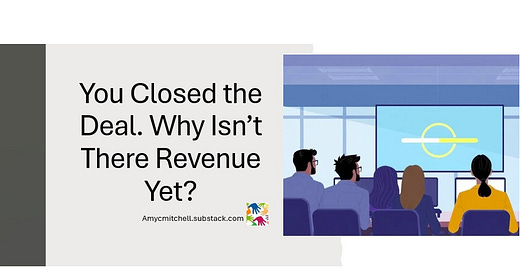You Closed the Deal. Why Isn’t There Revenue Yet?
Why Time to First Success Is an Overlooked Growth Lever
Your calendar says “Prepare business case,”
but your day says “Handle onboarding issues.”
You planned to spend the morning reviewing market data and refining a new product opportunity.
Instead, you're:
Fielding urgent IMs about customers who still haven’t onboarded
Escalating bugs blocking activation
Explaining (again) why last month’s win hasn’t turned into revenue
Onboarding issues have become a full-time job disguised as a side task.
And they’re quietly slowing your growth.
This article gives you a practical system for improving Time to First Success (TTFS) — the time between a customer deal and when they first experience real value from your product.
Time to First Success (TTFS) as a Shared Growth Goal
There is a surprising diversity of opinion about what marks the Time to First Success (TTFS) for customers. Before changing your onboarding process, align internally on what success looks like — and when a customer typically reaches it. This will vary by product and segment.
Map your customer’s early journey to identify key moments of value:
“Setup complete.”
“Data flowing.”
“First dashboard used.”
Use these signals to define TTFS — and build shared understanding across sales, engineering, and customer teams.
The Shift: From Reactive to TTFS-Driven Onboarding
You don’t fix onboarding with one workshop. You build a better system — piece by piece.
Start by replacing the product manager “safety net” with structural support.
It is normal for product teams to react to customer onboarding issues because customers have unique needs. However, continued escalations to the product managers to resolve onboarding issues delay business growth. To begin shifting from reactive customer onboarding issues to a new system, you focus on repeatable processes that improve a bit at a time.
The 5 Pillars of a TTFS System
These are the building blocks that reduce escalations and accelerate value:
Repeatable Offers
Standardized building blocks that reduce setup surprises.Pre-defined Onboarding Paths
Checklists aligned to common customer use cases.Clear Roles & Responsibilities
Everyone knows who owns each step in onboarding.Feedback Loops
You track and learn from onboarding — not just completing it.Celebration of Success
Turn first wins into customer stories and internal recognition.
Repeatable offers consist of pricing/packaging and go-to-market materials. Setting up repeatable offers allows customers to mix and match offers to fit their needs.
Step 1: Map What Happens After a Deal Closes
Before improving onboarding, understand what’s happening today.
Ask:
What happens after a customer orders?
Who runs the kickoff, and how do they know what was sold?
Who sets up the environment?
Who hands off the product — and when is the handoff considered done?
When is revenue recognized?
Don’t start by fixing. Start by mapping.
Step 2: Check if Onboarding Matches What You Sold
Now look at each major offer and ask:
Is the onboarding process clear?
Are the onboarding roles clear?
Use this to decide: Where do we clarify? Where do we refine? Where do we start measuring TTFS?
Step 3: Pilot TTFS with One Use Case
Don’t launch a dashboard. Start with a small pilot:
Pick one offer
Partner with a friendly sales engineer
Track a few early milestones (e.g., setup complete, first usage)
Share results with the team
Use these early wins to improve supporting materials like:
Qualification guides
Customization playbooks
Onboarding guides
Product documentation
GTM materials tied to customer milestones
Step 4: Add Lightweight Feedback Loops
Use light-touch processes to capture:
When the customer is ready to onboard
Whether they needed customization
How they’re learning the product
Whether they’ve told you they’re seeing value
Every onboarding becomes a source of insight, not just overhead.
What Changes When You Focus on TTFS
Once the system is in place, even informally, you’ll start to see:
Fewer escalations — teams know who owns what
Fewer onboarding stalls — sales avoids overpromising edge cases
Earlier signs of customer value — before your customer has issues
GTM teams equipped with real stories, not just theoretical outcomes
And more importantly:
Less “quick fix” discounting
More expansion orders
Less effort chasing renewals
Revenue that lands faster — and sticks longer
✅ Closing: TTFS as Your Product Growth Accelerator
You don’t need a new team. You need a new system.
You can’t control every onboarding, but you can design for faster first success — for your team and your customers.
This isn’t just a measurement exercise.
It’s a growth strategy dressed as a delivery problem.
Looking for more practical tips to improve your product management skills?
Check out Product Management Resources for free product management templates and guides.
Become a paid subscriber and get more weekly tips. Last week, paid subscribers learned about proving your business case. Can product managers show their business acumen?
Paid subscribers get access to 13+ templates and quick start guides.🎁
TLDR Product listed Product Management IRL articles recently! This biweekly email provides a consolidated list of recent product management articles.
Connect with Amy on LinkedIn, Threads, Instagram, and Bluesky for product management insights daily.











Getting to that quick win is so important. I see far too many apps that ask for my life history, my understanding of the Magna Carta, and a physical act of absolution before I can even get to that first screen, let alone first win!